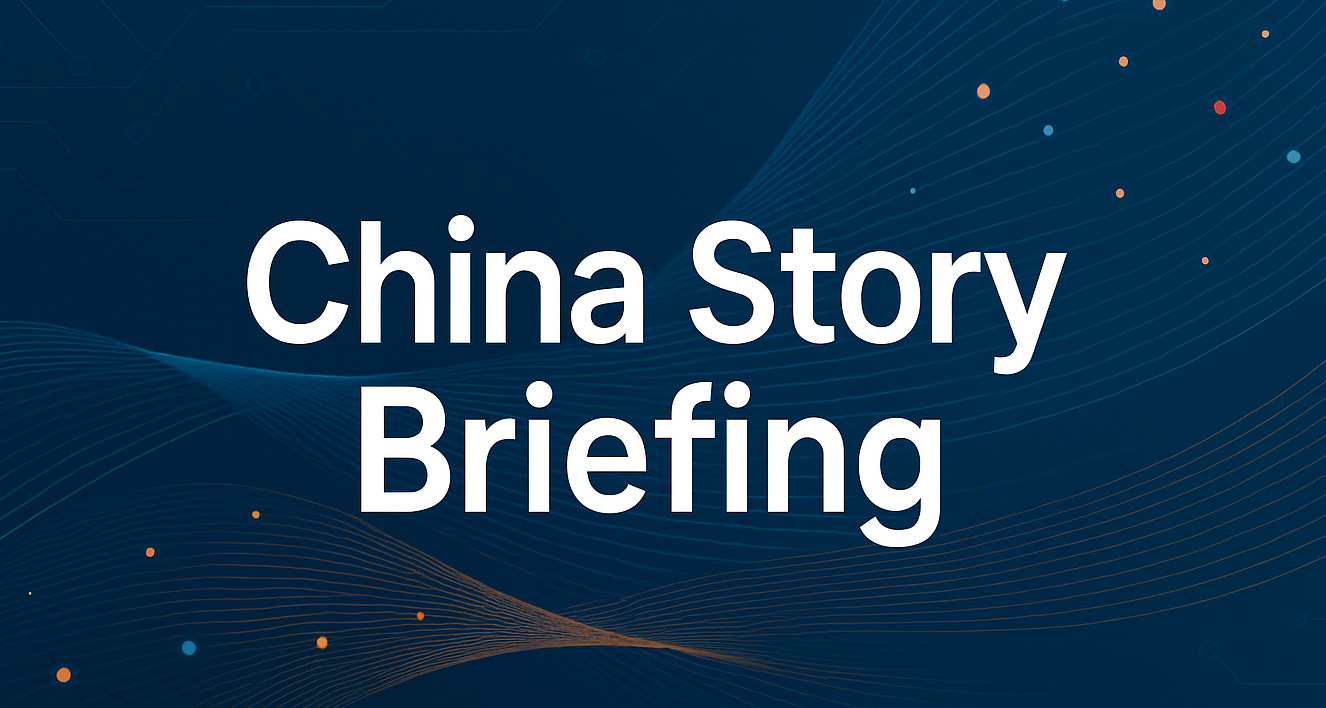China Story Briefing: "Coding is 30% of the Job" | June 18, 2025
How Chinese Founders See AI Remaking Software Engineering
Hi everyone, welcome to this issue of the China Story Briefing! This week, the global AI arms race entered a new phase with head-to-head chip giant confrontations, continued open-source model proliferation, and deepening AI Agent application scenarios. Geopolitics also remains a significant factor influencing tech supply chains and market access.
(Reminder: Besides this Briefing, more in-depth Deep Dives are in the works. All content is currently free.)
News
AI Models & Open Source Advances:
Tencent Open-Sources Hunyuan 3D 2.1, a Leading 3D Generation Model, at CVPR: This model, optimized for geometry and PBR textures and runnable on consumer GPUs, was fully open-sourced (code, weights, data pipeline), with over 1.8M downloads. [Source:AI New Media University]
ByteDance Releases Doubao LLM 1.6 & Seedance 1.0 Pro Video Model: ByteDance launched its Doubao LLM 1.6 series (256k context, multimodal reasoning) claiming a 63% overall cost reduction, alongside its Seedance 1.0 Pro video generation model. [Source: Weixin]
CAS Unveils "Qimeng" System for AI-Automated Full-Chip Design: The Chinese Academy of Sciences introduced "Qimeng," a system reportedly capable of fully automated hardware-software co-design for processor chips (successfully designed RISC-V CPU "Qimeng 2"). [Source: AIFrontier]
Xiaohongshu Open-Sources Text LLM dots.llm1 with Training Checkpoints: Xiaohongshu's hi lab open-sourced its MoE LLM and, notably, multiple training checkpoints, offering valuable resources for researching LLM learning dynamics. [Source: Xiaohongshu Technology REDtech]
Jensen Huang on Huawei & China's AI Compute Power: Nvidia's CEO stated Huawei could meet China's AI chip demand, and China's ample energy supports scaling AI compute via more chips. [Source: cnBeta.COM]
Takeaway: The open-source trend expands from models to specialized areas like 3D generation and training methodologies. AI empowering chip design emerges as a new path for China's self-sufficiency, while industry leaders offer perspectives on China's compute strategies.
AI Agents, Robotics & Frontier Exploration:
Manus Launches Free AI Chat Mode & Upgraded "Create" Features: AI Agent developer Manus updated its UI with a free Chat mode and enhanced "Create" options (PPT, image, video, web). [Source: AI Productivity ]
China Achieves First Successful Invasive Brain-Computer Interface Clinical Trial: A domestically developed invasive BCI reportedly allowed a quadriplegic man to control a computer via thoughts, featuring smaller implants and more flexible electrodes. [Source: AI New Media University]
Galaxy General & Tsinghua Release OpenWBT for Humanoid Robot Teleoperation: This open-source system supports multi-robot, cross-reality full-body teleoperation using just a VR headset and laptop. [Source: PMObserve]
Zhipu AI Launches "CoCo" Enterprise Autonomous Agent with Memory: Zhipu AI's CoCo agent for enterprises features "memory" of employee interactions and integrates with corporate knowledge bases. [Source: Zhipu AI]
Takeaway: AI Agent products continue to evolve in interaction and business models. Frontier "hard tech" like BCIs and humanoid robotics are seeing progress in China, with open-source aiding development. Enterprise AI Agents emphasize workflow integration and personalization.
China Policy & Market Insights:
WeChat Official Accounts Add E-commerce Features: Further integrating content and commerce. [Source: Sina Tech]
China Achieves Daylight Precision Laser Ranging to Lunar Satellite: A key breakthrough in deep space exploration technology. [Source: Glass Almanac]
Anker Recalls Over 1M Power Banks in US Due to Fire Risk: Highlighting product safety challenges for Chinese brands going global. [Source: Anker]
Takeaway: Chinese social platforms deepen e-commerce. The nation continues strategic investments in deep space exploration. Consumer electronics brands exporting globally must prioritize product safety and compliance.
China AI Voices
Chen Zhijie & Liu Xiaochun, Founders of Yanchuang Wanwu, on AI Software Engineering
Company Intro: Yanchuang Wanwu, founded early 2025 by ex-TikTok Head of Algorithm Chen Zhijie and veteran algorithm expert Liu Xiaochun, is an AI startup focused on reconstructing software development with Agent technology (AI SWE).
Key Insights (from their interview with Founder Park):
"Coding is only 30% of an engineer's job": Chen Zhijie argues AI's real opportunity is empowering the entire software engineering lifecycle (requirements, design, testing, deployment), not just code generation.
"AI Coding is laying bricks, AI SWE is constructing a building": Liu Xiaochun states AI SWE addresses complex systemic issues like architecture and tech stack selection, aiming for AI to participate in the entire "building" process.
Startups win via focus & agility, free from big-company "legacy baggage": They believe the AI SWE field is too complex for monopolies, allowing startups to tackle specific problems with more focus.
Future Engineers: Leading 100 Agents: They envision top engineers valued for their ability to coordinate many AI Agents efficiently, focusing on creative design and complex problem-solving.
Our Take: The insights from Yanchuang Wanwu's founders represent a key emerging theme in China's AI application landscape: a shift from AI-powered tool enhancement to the systemic re-engineering of entire workflows. Their deep understanding of AI SWE and vision for future human-AI collaboration reveal the profound potential of AI to transform productivity, especially in core digital infrastructure like software development.
Ideas
The "Second Wave" of Open Source: From Models to Ecosystems & Toolchains? From Tencent open-sourcing an industrial-grade 3D generation model, to Xiaohongshu releasing a text LLM with multiple training checkpoints, and Galaxy General/Tsinghua open-sourcing a humanoid teleoperation system. The scope of open source is deepening, extending beyond foundational models to specialized models, training methodologies, and even underlying control systems. How will this deeper "capability sharing" accelerate AI democratization and industry applications?
Data
AMD MI355X Transistors: 185 Billion.
Tencent Hunyuan 3D Open Source Downloads: Over 1.8 Million.
ByteDance Doubao 1.6 Context Length: 256k.
Xiaohongshu dots.llm1 Training Data: 11.2T Tokens.
CAS "Qimeng 2" RISC-V CPU Target Performance: ARM Cortex A53.
That's the wrap for this China Story Briefing. From head-to-head chip showdowns to the deepening of AI Agent applications and the continued surge of open-source contributions, tech evolution never ceases. We'll keep tracking these shifts next week! And don't forget, more in-depth Deep Dives are being polished.




